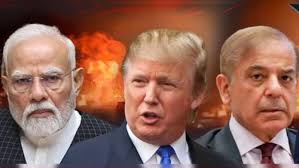US President Donald Trump has reiterated claims that he prevented a potential nuclear war between India and Pakistan earlier this year, using trade threats and a conversation with a “very terrific” Prime Minister Narendra Modi. Speaking at a White House cabinet meeting on August 27, 2025, Trump credited his intervention with securing a ceasefire following Operation Sindoor, triggered by the Pahalgam terror attack. However, India has consistently denied any third-party role, attributing de-escalation to direct military talks. This article explores the context, implications, challenges, and opportunities of this diplomatic narrative.
Context of the Claim
Incident Overview
-
Trump’s Statement: On August 27, 2025, Trump claimed he warned Pakistan against trade deals and tariffs, averting a nuclear conflict after seven jets were shot down.
-
Modi Praise: He described Modi as “very terrific,” recounting a call to de-escalate tensions.
-
Timeline: The crisis followed the May 7, 2025, Operation Sindoor, retaliating for the April 22 Pahalgam attack that killed 26.
Strategic Background
-
Trade Leverage: Trump used trade as a tool, threatening tariffs to enforce peace within five hours, he claims.
-
White House Support: Press Secretary Karoline Leavitt backed the narrative, citing eased global conflicts.
-
Historical Context: Tensions between India and Pakistan, nuclear-armed since 1998, have historical roots in Kashmir disputes.
National Context
-
Indian Denial: PM Modi and External Affairs Minister S. Jaishankar assert the ceasefire resulted from bilateral DGMO talks, not US intervention.
-
Pakistan’s Stance: PM Shehbaz Sharif thanked Trump, suggesting a Nobel Peace Prize, contrasting with India’s position.
-
Public Sentiment: X posts reflect mixed reactions, with some praising Trump’s role, others questioning its validity.
Implications of the Claim
Economic Impact
-
Trade Dynamics: Threatened tariffs could shift Pakistan’s trade focus, impacting India-US relations.
-
Economic Pressure: India’s $60.2 billion US export market faces strain, prompting diversification.
-
Regional Stability: Avertable conflict could preserve economic ties in South Asia.
Social and Institutional Impact
-
Diplomatic Relations: Trump’s praise for Modi strengthens personal rapport, though India rejects the narrative.
-
Military Credibility: India’s denial reinforces its autonomous defense posture.
-
Global Perception: The US claim positions Trump as a peacemaker, influencing international views.
Policy and Operational Impact
-
Geopolitical Strategy: US intervention highlights trade as a diplomatic weapon.
-
Ceasefire Mechanism: Bilateral talks’ success challenges third-party reliance.
-
Nuclear Discourse: The episode reignites debates on nuclear escalation risks.
Challenges
Operational Hurdles
-
Verification Issues: Discrepancies in jet numbers (five to seven) and timelines raise credibility concerns.
-
Coordination Gaps: Differing narratives complicate diplomatic alignment.
-
Logistical Strain: Trade threats’ enforcement requires sustained US-Pakistan engagement.
Economic and Social Concerns
-
Trade Fallout: Tariffs could harm Pakistan’s economy, straining regional stability.
-
Public Trust: India’s rejection may erode confidence in US mediation.
-
Misinformation Risk: Unsubstantiated claims could fuel regional mistrust.
Policy Risks
-
Diplomatic Tension: India’s denial risks US-India friction despite Modi-Trump ties.
-
Escalation Potential: Future conflicts may test the ceasefire’s durability.
-
International Backlash: Overstated claims could undermine US credibility.
Opportunities
Economic Advancement
-
Trade Realignment: Diversification could open new markets for India and Pakistan.
-
Investment Boost: Stability may attract regional economic initiatives.
-
Tariff Leverage: Strategic use could benefit US allies.
Social and Institutional Growth
-
Peace Building: Successful de-escalation could inspire confidence-building measures.
-
Military Dialogue: Bilateral talks’ success may encourage further cooperation.
-
Cultural Exchange: Reduced tensions could foster people-to-people ties.
Policy Leadership and Innovation
-
Mediation Model: A validated US role could set a precedent for global conflict resolution.
-
Nuclear Policy: The episode may prompt renewed arms control discussions.
-
Regional Strategy: Enhanced India-Pakistan dialogue could stabilize South Asia.



